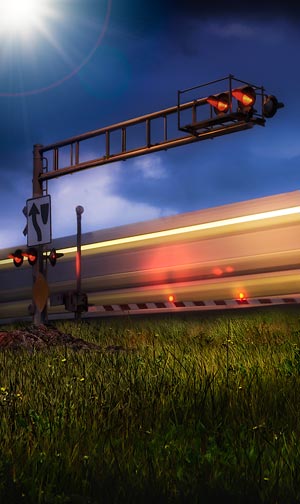Public Inconvenience and Disruption Grows as NTSB Investigates Bridge Collapse Caused by UP/BNSF Collision
(Rockview, Missouri – May 27, 2013)
Vickie Cantrell and Sarah Ishmael were both supposed to serve as bride’s maids at a friend’s wedding Saturday afternoon, but neither one even made it to the wedding. Both 19-year-olds were passengers in the 2000 Chevrolet Malibu driven by Vickie’s husband, Christopher Cantrell, 22, when they had the misfortune of attempting to cross the Route “M” Highway overpass above the interlocking crossing of Burlington Northern Santa Fe and Union Pacific Railroad tracks in Rockview, MO, just after a UPRR freight train had run into the side of a BNSF train that was already occupying the interlocking and collapsed two spans of the overpass.
Almost simultaneously, Larry Moore, 30, the driver of a 2010 Nissan Versa, with Angela Donley, 38, as his passenger, approached the overpass in the same westbound direction as Cantrell and his passengers.
Missouri State Highway Patrol Trooper Clark Parrott said that neither vehicle was on the bridge when it collapsed, but entered the bridge’s incline as it came down, making stopping in time to avoid the crash by stopping physically impossible.
All five travelers on the highway, who were all residents of Chafee, MO, were injured, with Vickie Cantrell suffering a broken leg and fractured ankle and the others receiving more moderate injuries.
All five victims were transported to St. Francis Medical Center in Cape Girardeau, MO, as were the engineer and conductor of the Union Pacific train which was involved in the collision that resulted in derailed freight cars and locomotives striking the main support of the bridge and collapsing both spans.
As generally occurs, the train crewmen were treated in anonymity, with their names being withheld to prevent intrusion by the news media. Railroad officials whisked the pair away immediately after they were treated and released from the hospital.
A total of two dozen freight cars, 11 from the UPRR train and 13 on the BNSF train, were derailed, as were the Union Pacific locomotives, which caught fire after the impact. Nearby resident Wayne Woods noted that “When I got over there, the train was on its side.” As he watched, emergency responders “got the guys out and lifted them off the train and got them off the overpass.” Noting the condition of the two crew members, Woods said “One was kind of bloody; the other one looked like he was pretty shook up.”
As daylight gleamed across the wreck site, the two collapsed 40-foot-long sections of the overpass, weighing a total of 371 tons, were laying across derailed freight cars and charred locomotives, with the vehicles occupied by the innocent victims of the wreck still where they collided with the broken spans.
The remains of brand new automobiles peeked through the wreckage of railroad automobile, pickup truck and SUV transportation cars, many smashed beyond any possibility of repair.
Morning also brought an order by the National Transportation Safety Board to cease any derailment clearing activities until the NTSB’s rail accident investigators reached the scene and began the preliminaries of their official investigation. Union Pacific crews were finally allowed to proceed with derailment clearance activities about 5:30 P.M. late Saturday afternoon.
NTSB Lead Investigator Robert Sumwalt said his team would be on site for from four to seven days, and that a final report on the wreck could take up to a year. “I feel very lucky that we have no fatalities involved,” said Sumwalt during a brief, preliminary Saturday afternoon news conference “It’s still something that should not happen. Two trains should not be at the same place at the same time. Anytime we have something like that, we are very concerned about it. That’s why we’re here. We are here to find out what happened, so we can learn from it and keep it from happening again,” he concluded.
NTSB inspectors also seized the UP locomotive’s nose camera video recording, viewed it, and sent it on to Washington, DC so NTSB headquarters staff could analyze it. Sumwalt called the videotape “a pretty good video, because it shows everything up to and after the point of impact.”
The loss of the highway thoroughfare, which was only 15 years old and had just been inspected and found to be in good condition by inspectors from the Missouri Dept. of Transportation in February of this year, will inconvenience area residents for quite some time. About 3,500 vehicles cross the overpass weekly, and MODOT officials estimate it will be September before the three million dollar structure can be replaced.
“The damage is very extensive,” noted Mark Shelton, MODOT’s Southeast Region engineer. “We’re going to end up removing the entire bridge and completely replacing it.”
He added that the situation of the loss of the overpass has been declared an emergency, and that he expected to have an engineer in place to begin designing the replacement structure by Tuesday.
When asked who would be footing the $3 million bill for replacement of the overpass, Shelton declared “We’ll have to go through the investigation and all that stuff and figure out liability. But our bridge was just standing there.” Thus, the MODOT engineer surmised that “certainly, we’ll be looking to the railroad for recovery.”


